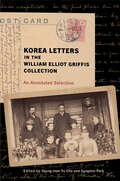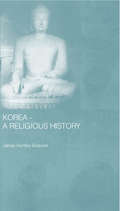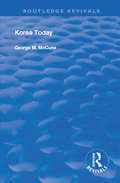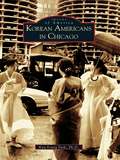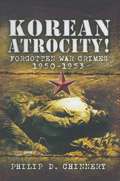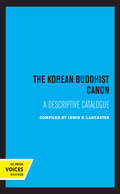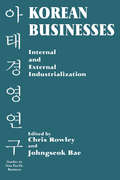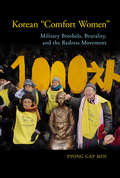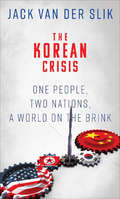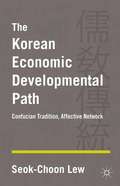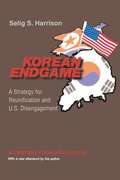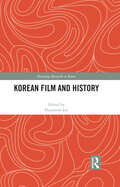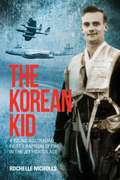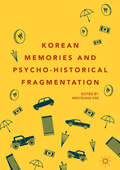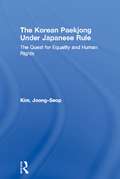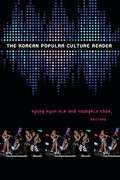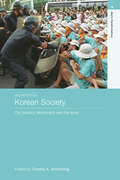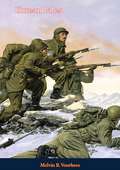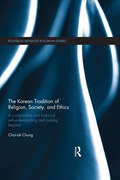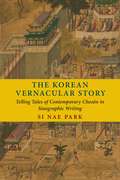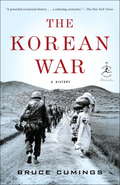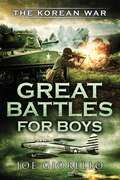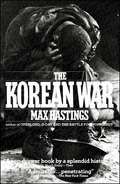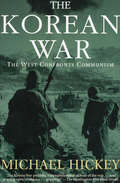- Table View
- List View
Korea Letters in the William Elliot Griffis Collection: An Annotated Selection
by William Eilliot GriffisWilliam Elliot Griffis (1843 – 1928) graduated from Rutgers College in 1869 and taught four years in Fukui and Tokyo. After his return to the United States, he devoted himself to his research and writing on East Asia throughout his life. He authored 20 books about Japan and five books about Korea including, Corea: The Hermit Nation (1882), Corea, Without and Within: Chapters on Corean History, Manners and Religion (1885), The Unmannerly Tiger, and Other Korean Tales (1911), A Modern Pioneer in Korea: The Life Story of Henry G. Appenzeller (1912), and Korean Fairy Tales (1922). In particular, his bestseller, Corea: The Hermit Nation (1882) was reprinted numerous times through nine editions over thirty years. He was not only known as "the foremost interpreter of Japan to the West before World War I but also the American expert on Korea. After his death, his collection of books, documents, photographs and ephemera was donated to Rutgers. The Korean materials in the Griffis Collection at Rutgers University consist of journals, correspondence, articles, maps, prints, photos, postcards, manuscripts, scrapbooks, and ephemera. These papers reflect Griffis's interests and activities in relation to Korea as a historian, scholar, and theologian. They provide a rare window into the turbulent period of late nineteenth- and twentieth-century Korea, witnessed and evaluated by Griffis and early American missionaries in East Asia. The Korea Letters in the William Elliot Griffis Collection are divided into two parts: letters from missionaries and letters from Japanese and Korean political figures. Newly available and accessible through this collection, these letters develop a multifaceted history of early American missionaries in Korea, the Korean independence movement, and Griffis's views on Korean culture.
Korea - A Religious History
by James H. GraysonThis is an historical survey of all the religious traditions of Korea in relation to the socio-cultural trends of seven different periods of Korean history. The book includes a discussion of the history of the study of religion in Korea, a chronological description of Korean folk religion including shamanism, Buddhism, Confucianism, Roman Catholicism and Protestantism, Islam, and Korean New Religions, and some final observations about the unique characteristics of religious beliefs and practices in Korea.
Korea Today (Routledge Revivals #3)
by George M. McCunePublished in 1950: Here is the first comprehensive study of Korea since its liberation and division. Written by an outstanding American authority with long personal knowledge of the country, it provides an analysis of the American and Russian military occupations, the efforts of the United Nations to deal with the problem of Unification of the country, the political and economic policies followed in the northern and southern regimes, and an appraisal of the U.S. program of economic and military aid to South Korea.
Korean Americans in Chicago
by Kyu Young ParkKoreans first began to immigrate to Chicago at the turn of the 20th century. Drawn to the Windy City in search of a better life for themselves and their families, Korean Americans quickly began to establish what has become a thriving community that remains active and distinct. For the past 100 years, the Korean American community has contributed greatly to the growth and development of the Chicago metropolitan area-politically, culturally, and socially. In this book Korean Americans in Chicago celebrate these contributions with over 200 photographs that detail the various aspects of life within the community.
Korean Atrocity!: Forgotten War Crimes 1950–1953
by Philip D. ChinneryAs there was no clear victor at the conclusion of the Korean War, no war crime trials were held. But, as this book reveals, there is evidence of at least 1,600 atrocities and war crimes perpetrated against troops serving with the United Nations command in Korea. The bulk of the victims were Americans but many British servicemen were tortured, killed or simply went missing.Much of the carefully researched material in this book is horrific but the stark truth is that those North Koreans and Chinese responsible went unpunished for their shameful deeds.Korean Atrocity examines the three phases of this little known but bitter conflict from the POWs perspective the first phase when the two warring factions fought themselves to a stalemate, next, the treatment of POWs in North Korea and China, and finally the repatriation/post active conflict period. During the third phase it was realised that a staggering 7956 Americans and 100 British servicemen were unaccounted for. Many POWs were not released until two years after the end of hostilities. Bizarrely the US Government insisted on a news black-out on those left behind which raises questions as to what has been done to find the missing.This is a shocking, sobering and thought-provoking book.
The Korean Buddhist Canon: A Descriptive Catalogue (Center for Korean Studies, UC Berkeley #4)
by Lewis R. LancasterThis title is part of UC Press's Voices Revived program, which commemorates University of California Press’s mission to seek out and cultivate the brightest minds and give them voice, reach, and impact. Drawing on a backlist dating to 1893, Voices Revived makes high-quality, peer-reviewed scholarship accessible once again using print-on-demand technology. This title was originally published in 1979.
Korean Businesses: Internal and External Industrialization (Studies In Asia Pacific Business)
by CHRIS ROWLEY; JOHNGSEOK BAEEssays in the book focus on the Korean model of industrialization and internal internationalization, organizational capabilities and management roles, and disadvantages inherent in the model. The subjects covered include corporate catch-up strategies, foreign investment, and future possibilities.
Korean "Comfort Women": Military Brothels, Brutality, and the Redress Movement (Genocide, Political Violence, Human Rights)
by Pyong Gap MinArguably the most brutal crime committed by the Japanese military during the Asia-Pacific war was the forced mobilization of 50,000 to 200,000 Asian women to military brothels to sexually serve Japanese soldiers. The majority of these women died, unable to survive the ordeal. Those survivors who came back home kept silent about their brutal experiences for about fifty years. In the late 1980s, the women’s movement in South Korea helped start the redress movement for the victims, encouraging many survivors to come forward to tell what happened to them. With these testimonies, the redress movement gained strong support from the UN, the United States, and other Western countries. Korean “Comfort Women” synthesizes the previous major findings about Japanese military sexual slavery and legal recommendations, and provides new findings about the issues “comfort women” faced for an English-language audience. It also examines the transnational redress movement, revealing that the Japanese government has tried to conceal the crime of sexual slavery and to resolve the women’s human rights issue with diplomacy and economic power.
The Korean Crisis: One People, Two Nations, a World on the Brink
by Jack Van Der SlikAn in-depth portrait of the two Koreas and their turbulent relationship—from the author of Eisenhower: A 20th Century Hero in War and Peace.After nearly 70 years of division between North and South Korea, the two nations have not yet achieved a peaceful settlement. Professor Emeritus Jack Van Der Slik&’s book provides a first person account of the incredible differences between the nations.The Korean Crisis: One People, Two Nations, an Uncertain Future follows the fate of the two Koreas. The first is a story of hard-earned success by the South Korean people. Although democracy did not come easily, it did accompany flourishing through market capitalism. The second, the fall of the Democratic People&’s Republic of Korea, began with early economic success then sank into a socialist dictatorship, stratifying the country&’s people into a small privileged elite supported by a poor and cheerless mass of disadvantaged workers. Despite the poverty and food insecurity suffered by the North Korean underclass, the ruling elite has formidably armed itself with nuclear weapons and a massive standing army.The Korean Crisis draws upon deep studies of democratization in South Korea and Van Der Slik&’s own travels throughout the Republic of Korea and Panmunjom—the heavily armed 38th parallel and the site of peace negotiations. Intensely researched, highly informative, and poignantly told, The Korean Crisis will educate the public about Korea and the dangers that exist there while shedding light on a possible catastrophic nuclear conflict between the two rival countries whose combatants are, in fact, one people.
Korean Crisis and Recovery
by David T. Coe Se-Jik KimThis volume contains papers presented at a May 2001 conference in Seoul sponsored by the IMF and the Korea Institute for International Economic Policy on the Korean Crisis and Recovery. The papers examine the response to the 1997 crisis, its long-term impact on growth, and the state of financial and corporate sector reforms. Authors include academics, Korean policymakers, and IMF and World Bank staff involved in the Korean program. [from the IMF website]
The Korean Economic Developmental Path
by Seok-Choon LewThis book defines the Korean development as the moral economy of growth derived from a synergy between strong state and strong society and argues that Confucian cultural orientation has played a critical role in the process.
Korean Endgame: A Strategy for Reunification and U. S. Disengagement
by Selig S. HarrisonNearly half a century after the fighting stopped, the 1953 Armistice has yet to be replaced with a peace treaty formally ending the Korean War. While Russia and China withdrew the last of their forces in 1958, the United States maintains 37,000 troops in South Korea and is pledged to defend it with nuclear weapons. In Korean Endgame, Selig Harrison mounts the first authoritative challenge to this long-standing U.S. policy. Harrison shows why North Korea is not--as many policymakers expect--about to collapse. And he explains why existing U.S. policies hamper North-South reconciliation and reunification. Assessing North Korean capabilities and the motivations that have led to its forward deployments, he spells out the arms control concessions by North Korea, South Korea, and the United States necessary to ease the dangers of confrontation, centering on reciprocal U.S. force redeployments and U.S. withdrawals in return for North Korean pullbacks from the thirty-eighth parallel. Similarly, he proposes specific trade-offs to forestall the North's development of nuclear weapons and missile delivery systems, calling for the withdrawal of the U.S. nuclear umbrella in conjunction with agreements to denuclearize Korea embracing China, Russia, and Japan. The long-term goal of U.S. policy, he argues, should be the full disengagement of U.S. combat forces from Korea as part of regional agreements insulating the peninsula from all foreign conventional and nuclear forces. A veteran journalist with decades of extensive firsthand knowledge of North Korea and long-standing contacts with leaders in Washington, Seoul, and Pyongyang, Harrison is perfectly placed to make these arguments. Throughout, he supports his analysis with revealing accounts of conversations with North Korean, South Korean, and U.S. leaders over thirty-five years. Combining probing scholarship with a seasoned reporter's on-the-ground experience and insights, he has given us the definitive book on U.S. policy in Korea--past, present, and future.
Korean Film and History (Routledge Research on Korea)
by Hyunseon LeeCinema has become a battleground upon which history is made – a major mass medium of the twentieth century dealing with history. The re-enactments of historical events in film straddle reality and fantasy, documentary and fiction, representation and performance, entertainment and education. This interdisciplinary book examines the relationship between film and history and the links between historical research and filmic (re-)presentations of history with special reference to South Korean cinema. As with all national film industries, Korean cinema functions as a medium of inventing national history, identity, and also establishing their legitimacy – both in forgetting the past and remembering history. Korean films also play a part in forging cultural collective memory. Korea as a colonized and divided nation clearly adopted different approaches to the filmic depiction of history compared to colonial powers such as Western or Japanese cinema. The Colonial Period (1910-45) and Korean War (1950-53) draw particular attention as they have been major topics shaping the narrative of nation in North and South Korean films. Exploring the changing modes, impacts and functions of screen images dealing with history in Korean cinema, this book will be of huge interest to students and scholars of Korean history, film, media and cultural studies.
The Korean Kid: A Young Australian Pilot's Baptism of Fire in the Jet Fighter Age
by Rochelle NichollsA vicious civil conflict erupted on the Korean peninsula in 1950 and sucked 24 nations into a new round of fighting. The world’s two atomic superpowers – the United States and the Soviet Union – menaced each other across an arbitrary border as Korea became the proving ground for a new Cold War. The odds faced by Australia’s young pilots were one in three, that they’d not come back. Or perhaps they’d just never be found, crash in flames into a foreign mountain and become nothing but names in a faraway cemetery. Most had no combat experience. Their planes were obsolete. Their orders were to dive upon a well-armed enemy with their bellies exposed, where one bullet to a fuel-tank meant an inescapable fireball. The Korean Kid is the story of Jim Kichenside and the Australian pilots who took to the skies in the ‘forgotten war’ on the Korean peninsula. Within a week of the North Korean invasion of the South on June 25, 1950, No.77 Fighter Squadron RAAF were in the air: the first United Nations air unit committed to the defence of the overrun South. Of the 340 Australians who perished in Korea, 41 were from 77 Squadron. In 1952, Jim Kichenside was the youngest pilot in 77 Squadron, at just 21 years of age. He entered the Korean theatre with just 8 hours of training on his Meteor jet. Dubbed ‘The Korean Kid’, Jim's is a story of youth and resilience, of luck and loss, of young men thrust into a war against impossible odds – the first war of the jet age.
Korean Memories and Psycho-Historical Fragmentation
by Mikyoung KimThis pioneering book is the first English volume on Korean memories. In it, Mikyoung Kim introduces ‘psycho-historical fragmentation’, a concept that explains South Korea’s mnemonic rupture as a result of living under intense temporal, psychological and physical pressure. As Korean society has undergone transformation at unusual speed and intensity, so has its historical memory. Divided into three sections, on lingering colonial legacies, the residuals of the Cold War and Korean War, and Korea’s democracy movement in the 1980s, Korean Memories and Psycho-Historical Fragmentation aims to tell multi-layered, subtle and lesser-known stories of Korea’s historical past. With contributions from interdisciplinary perspectives, it reveals the fragmentation of Korean memory and the impact of silencing.
The Korean Paekjong Under Japanese Rule: The Quest for Equality and Human Rights
by Joong-Seop KimTraditional Korean society was characterized by a rigid hierarchy. The minority Paekjong were the lowest group of the lowest rank of the shinbun class system, and were treated as outcasts throughout the Choson period (1392-1910). This book deals with their historical and social background, and their struggle for human rights and equality in colonial Korea through the activities of the Hyongpyongsa (Association for an Equitable Society), active from c.1923 to 1935. The Hyongpyongsa was the longest-lasting social movement during the colonial period, and its activities provoked confrontations with fellow Koreans as well as with the Japanese colonial powers. Through analysis of the social environment as well as their actions, this study reveals the complexity of early twentieth century Korea's drive towards modernization.
The Korean Popular Culture Reader
by Youngmin Choe Kyung Hyun KimOver the past decade, Korean popular culture has become a global phenomenon. The "Korean Wave" of music, film, television, sports, and cuisine generates significant revenues and cultural pride in South Korea. The Korean Popular Culture Reader provides a timely and essential foundation for the study of "K-pop," relating the contemporary cultural landscape to its historical roots. The essays in this collection reveal the intimate connections of Korean popular culture, or hallyu, to the peninsula's colonial and postcolonial histories, to the nationalist projects of the military dictatorship, and to the neoliberalism of twenty-first-century South Korea. Combining translations of seminal essays by Korean scholars on topics ranging from sports to colonial-era serial fiction with new work by scholars based in fields including literary studies, film and media studies, ethnomusicology, and art history, this collection expertly navigates the social and political dynamics that have shaped Korean cultural production over the past century.Contributors. Jung-hwan Cheon, Michelle Cho, Youngmin Choe, Steven Chung, Katarzyna J. Cwiertka, Stephen Epstein, Olga Fedorenko, Kelly Y. Jeong, Rachael Miyung Joo, Inkyu Kang, Kyu Hyun Kim, Kyung Hyun Kim, Pil Ho Kim, Boduerae Kwon, Regina Yung Lee, Sohl Lee, Jessica Likens, Roald Maliangkay, Youngju Ryu, Hyunjoon Shin, Min-Jung Son, James Turnbull, Travis Workman
Korean Society: Civil Society, Democracy and the State (Asia's Transformations)
by Charles K. ArmstrongWhile most analyses of Korean politics have looked to elites to explain political change, this new and revised edition of Korean Society examines the role of ordinary people in this dramatic transformation. Taking the innovative theme of 'civil society' - voluntary organizations outside the role of the state which have participated in the process of political and social democratization - the essays collected here examine Korea as one of the most dramatic cases in the world of ordinary citizens participating in the transformation of politics. Key topics discussed include: comparisons of Korean democratization to the experiences of post-authoritarian regimes elsewhere in the world comparisons of the theory of civil society as developed in Western Europe and America the legacy of Korea's Confucian past for contemporary politics and society close examinations of various civil society movements South Korea and North Korea. Conceptually innovative, up-to-date and timely, the new edition of this book will be an invaluable resource for students of contemporary Korea, Asian politics and the global struggle for democracy.
Korean Tales
by Melvin B. VoorheesThis book is a first-hand account, based on personal experiences and observation, of a war unique in history and vital for the future of our civilisation. Part of the book is written in the form of fictional stories, each closely based on actual events, which reveal vividly the reactions of the fighting men and of the natives of a war-torn country.“THIS is a blessed event. At last the United States Army has given birth to a top-grade writer. From the Korean war has come finally one thin volume of prose which is apt to be remembered long after we have forgotten the heroisms of Heartbreak Ridge and the frustrations of Panmunjom.”—NY Times
The Korean Tradition of Religion, Society, and Ethics: A Comparative and Historical Self-understanding and Looking Beyond (Routledge Advances in Korean Studies)
by Chai-sik ChungBy making Korea a central part of comparative history of East Asian religion and society, this book traces the evolution of Korean religion from the oldest representation to that of the current day by utilizing wide-ranging interdisciplinary and comparative resources. This book presents a holistic view of the enduring religious tradition of Korea and its cultural and social significance within the wider horizons of modern and globalizing changes. Reflecting nearly five decades of the author’s work on the subject, it presents an understanding of the main current in Korean religion and social thought throughout history. It then goes on to examine discourses on values and morality involving the relationship between religion and society, in particular the human meaning of economy and society, which is one of the most central and practical problems in the contemporary world with global relevance beyond Korea and Asia. Addressing the overview of the Korean religious tradition in the context of its impact on the making of modern society and economy, this book will appeal to students and scholars of Religious Studies, Korean Studies and Asian Studies.
The Korean Vernacular Story: Telling Tales of Contemporary Chosŏn in Sinographic Writing
by Si Nae ParkAs the political, economic, and cultural center of Chosŏn Korea, eighteenth-century Seoul epitomized a society in flux: It was a bustling, worldly metropolis into which things and people from all over the country flowed. In this book, Si Nae Park examines how the culture of Chosŏn Seoul gave rise to a new vernacular narrative form that was evocative of the spoken and written Korean language of the time.The vernacular story (yadam) flourished in the nineteenth century as anonymously and unofficially circulating tales by and for Chosŏn people. The Korean Vernacular Story focuses on the formative role that the collection Repeatedly Recited Stories of the East (Tongp’ae naksong) played in shaping yadam, analyzing the collection’s language and composition and tracing its reception and circulation. Park situates its compiler, No Myŏnghŭm, in Seoul’s cultural scene, examining how he developed a sense of belonging in the course of transforming from a poor provincial scholar to an urbane literary figure. No wrote his tales to serve as stories of contemporary Chosŏn society and chose to write not in cosmopolitan Literary Sinitic but instead in a new medium in which Literary Sinitic is hybridized with the vernacular realities of Chosŏn society. Park contends that this linguistic innovation to represent tales of contemporary Chosŏn inspired readers not only to circulate No’s works but also to emulate and cannibalize his stylistic experimentation within Chosŏn’s manuscript-heavy culture of texts.The first book in English on the origins of yadam, The Korean Vernacular Story combines historical insight, textual studies, and the history of the book. By highlighting the role of negotiation with Literary Sinitic and sinographic writing, it challenges the script (han’gŭl)-focused understanding of Korean language and literature.
The Korean War: A History (Modern Library Chronicles)
by Bruce CumingsAs Cumings eloquently explains, for the Asian world the Korean War was a generations-long fight that still haunts contemporary events. He shares the neglected history of occupation of Korea and the untold stories of bloody insurgencies and rebellions in that divided land.
The Korean War (Great Battles for Boys)
by Joe Giorello Sibella GiorelloEach book in the series focuses on the battles, leaders, tactics, and weapons that won (or lost) history’s most significant military clashes. Filled with historic photos and written in an engaging conversational style by a middle school history teacher, Great Battles for Boys brings history to life. These true tales of courage will excite even the most reluctant readers. <p><p> In this seventh book in the series, boys learn about The Korean War (1950-53) also known as the “The Forgotten War.” Despite more than 2 million casualties, most people—young and old—can not fully explain this international conflict or why the United States sacrificed so much treasure to fight it.
Korean War
by Max HastingsIt was the first war we could not win. At no other time since World War II have two superpowers met in battle.Now Max Hastings, preeminent military historian takes us back to the bloody bitter struggle to restore South Korean independence after the Communist invasion of June 1950. Using personal accounts from interviews with more than 200 vets--including the Chinese--Hastings follows real officers and soldiers through the battles. He brilliantly captures the Cold War crisis at home--the strategies and politics of Truman, Acheson, Marshall, MacArthur, Ridgway, and Bradley--and shows what we should have learned in the war that was the prelude to Vietnam.
The Korean War: The West Confronts Communism
by Michael HickeyAn authoritative account by the historian and Korean War vet offers “a comprehensive picture of the war . . . and riveting tales of heroics . . . Gripping” (The Washington Post Book World). Winner of the Westminster Medal for Military Literature On June 25, 1950, the North Korean People’s Army shocked American troops by crossing the 38th parallel into South Korea. After five years of relative quiet following the close of World War II, the US Army was unprepared to face a battle-ready enemy. After an initial defeat, General MacArthur turned the tides along with significant contributions from UN allies. Joining the Americans were troops from Britain, Australia, Canada, New Zealand, South Africa, Turkey, and elsewhere, working together despite problems of culture and logistics. In The Korean War, Michael Hickey frames the conflict in the larger context of international power politics. A veteran of the war himself, he recounts such masterstrokes as MacArthur’s landing behind the enemy lines at Inchon, the drama of the glorious Glosters episode, and both collaboration and mutiny in the prisoner-of-war camps of either side. Drawing on many previously unexamined sources from several countries, including recently declassified documents, regimental archives, diaries, and interviews, Hickey adds extensively to our knowledge of one of the most significant conflicts of modern times. “[A] fine, opinionated contribution to Korean War literature . . . Not to be missed.” —Publishers Weekly
